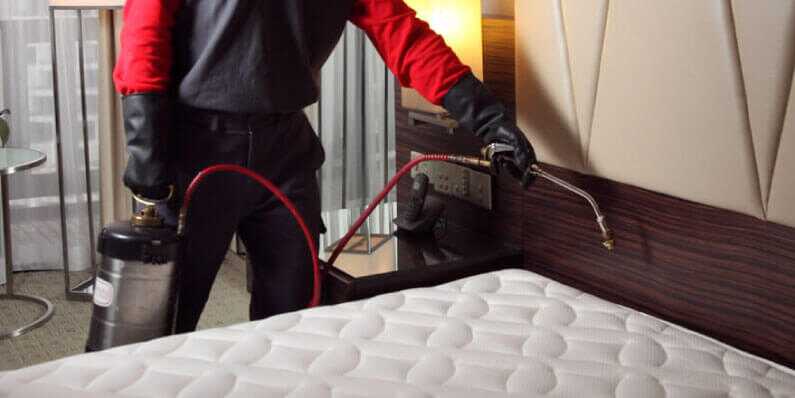Expert Bed Bug Exterminator: DC Providers and Heat Treatment
Expert Bed Bug Exterminator: DC Providers and Heat Treatment
Blog Article
Checking Out the Scientific Research Behind Bed Insect Warmth Treatments as a Lasting Parasite Administration Technique
In the realm of pest monitoring, the quest for sustainable and reliable options remains a continuous search. One such method that has gained grip over the last few years is making use of warm treatments to deal with bed bug invasions. By harnessing the science behind thermal fatality points for these persistent parasites, heat therapies use a promising alternative to standard chemical-based approaches. The intricacies of exactly how warmth successfully gets rid of bed bugs and the wider implications for sustainable bug administration techniques make this a subject worth exploring even more.
Bed Insect Warmth Therapy Process

Thermal Death Point for Bed Bugs
Exposing bed pests to elevated temperatures past their thermal resistance array is essential for accomplishing reliable removal in warm therapy procedures. The thermal death factor for bed bugs describes the temperature at which these insects can not survive. Research suggests that bed pests start to perish when exposed to temperature levels above 113 ° F(45 ° C) for a continual period. As the temperature enhances, so does the death rate of bed bugs. At around 118 ° F(48 ° C ), bed pests start to pass away swiftly, with a death rate of almost 99% within minutes of exposure. This demonstrates the sensitivity of bed pests to heats and highlights the efficiency of warmth treatments in getting rid of infestations. By reaching and keeping temperatures over the thermal death factor for bed bugs, parasite monitoring specialists can guarantee detailed elimination of bed insect populaces, including hard-to-reach locations where chemical therapies may be less efficient. Comprehending the thermal death factor for bed pests is important for carrying out successful heat treatment strategies and attaining sustainable parasite administration end results.
Advantages of Heat Treatments
Having actually established the essential thermal death point for bed pests, it is vital to now check out the substantial advantages that heat therapies offer in properly eliminating these resilient bugs. One of the primary advantages is that heat can penetrate deep read more right into fractures and holes where bed bugs hide, ensuring that even the most hard-to-reach locations are warmed to deadly temperature levels.
Moreover, warm therapies are eco friendly and safe, making them a lasting insect management technique. Unlike chemical pesticides, warm treatments do not leave dangerous deposits that can position threats to human wellness or the setting. This facet is specifically essential in delicate settings such as medical facilities, colleges, and household areas where chemical usage may not be desirable.
Furthermore, warmth treatments have a high success price in getting rid of bed pest infestations in a single treatment, reducing the demand for numerous sees and reducing disruption to owners. This performance not only saves money and time yet likewise provides comfort to those managing bed bug problems.
Efficiency of Warmth Treatment

Warmth therapies have the added advantage of killing bed insect eggs, which are commonly resistant to standard chemical therapies. In general, the effectiveness of warmth treatments in getting rid of bed bug invasions makes them a trustworthy and lasting bug monitoring strategy.
Lasting Insect Management Conveniences
Executing sustainable parasite monitoring practices supplies long-term advantages for both the environment and public wellness. By utilizing techniques such as warm treatments for bug control, we can reduce the reliance on harmful chemical pesticides that can have damaging impacts on ecological communities and human health and wellness - exterminator. Sustainable parasite administration methods aid in preserving biodiversity by targeting particular insects without hurting non-target organisms, thus maintaining a balanced ecological community
Additionally, sustainable bug administration methods add to the total health and click site wellness and well-being hop over to these guys of the public. By lessening direct exposure to poisonous chemicals used in standard parasite control methods, warmth treatments supply a safer option for pest management in household, industrial, and public areas. This reduction in chemical use likewise aids in preventing pesticide residues from infecting air, dirt, and water, securing ecological top quality.
Final Thought
In conclusion, bed insect warmth therapies have been shown to be a efficient and lasting insect administration technique. The thermal death factor for bed pests makes them vulnerable to warmth therapies, which have many advantages over standard chemical therapies. The effectiveness of warm therapies in removing bed bug problems while reducing environmental impact highlights the capacity of this technique as a lasting option for insect control.
The bed bug warm treatment process entails elevating the temperature within plagued locations to a level that efficiently eliminates bed bugs and their eggs. By reaching and keeping temperatures over the thermal death factor for bed bugs, bug administration professionals can ensure extensive elimination of bed pest populaces, including hard-to-reach areas where chemical therapies may be less efficient. One of the main advantages is that heat can penetrate deep right into gaps and fractures where bed insects hide, making certain that also the most hard-to-reach locations are warmed to dangerous temperatures. Unlike chemical treatments that may leave behind resistant populaces, warm treatments offer a non-toxic and environmentally pleasant solution that can penetrate deep into furniture, walls, and various other hard-to-reach locations where bed bugs conceal.
The thermal death factor for bed bugs makes them at risk to warmth therapies, which have countless benefits over typical chemical treatments.
Report this page